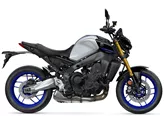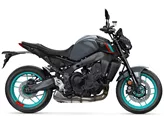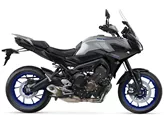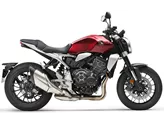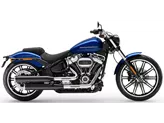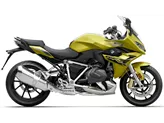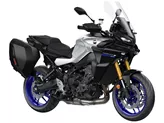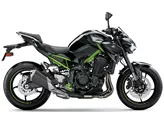Kawasaki Z 800 2013 vs. Yamaha MT-09 2017

Kawasaki Z 800 2013

Yamaha MT-09 2017
Overview - Kawasaki Z 800 2013 vs Yamaha MT-09 2017
The Kawasaki Z 800 model year 2013 and the Yamaha MT-09 model year 2017 are both naked bikes with similar engine types, in-line configurations, and liquid cooling systems. However, there are several differences between the two models that should be considered.
In terms of engine power, the Kawasaki Z 800 2013 has a slightly lower output with 113 HP compared to the Yamaha MT-09 2017, which boasts 115 HP. Similarly, the torque of the Yamaha MT-09 2017 is slightly higher at 87.5 Nm compared to the 83 Nm of the Kawasaki Z 800 2013. The Yamaha MT-09 2017 has three cylinders, while the Kawasaki Z 800 2013 has four.
Both bikes feature upside-down telescopic forks for the front suspension, providing stability and control during rides. However, the Yamaha MT-09 2017 has an advantage in terms of its chassis, as it is made of aluminum, which is known for its lightweight and durable properties. In contrast, the Kawasaki Z 800 2013 has a steel frame, which may add some weight to the bike.

Kawasaki Z 800 2013
Both bikes have double disk brakes at the front, ensuring efficient stopping power. They also share the same tire dimensions, with a width of 120 mm and a diameter of 17 inches for both the front and rear tires. The wheelbase of the two models is also quite similar, with the Kawasaki Z 800 2013 measuring at 1445 mm and the Yamaha MT-09 2017 at 1440 mm.
When it comes to seat height, the Yamaha MT-09 2017 has a lower seat height of 815 mm compared to the 834 mm of the Kawasaki Z 800 2013. Additionally, the fuel tank capacity of the Yamaha MT-09 2017 is slightly smaller at 14 liters, while the Kawasaki Z 800 2013 can hold up to 17 liters of fuel.

Yamaha MT-09 2017
In terms of strengths, the Kawasaki Z 800 2013 is known for its eye-catching and chunky look, confident acceleration, relaxed geometry, and powerful brakes. On the other hand, the Yamaha MT-09 2017 offers additional strengths such as Öhlins suspension, Akrapovic exhaust for improved optics and sound, Magura HC3 radial brake pump for enhanced braking performance, and Carbon2Race covers for a grandiose appearance. The combination of seat, footrests, and handlebar clamps on the Yamaha MT-09 2017 is also highly effective.
However, both models have their weaknesses. The Kawasaki Z 800 2013 has limited freedom of movement for the legs, which may be a drawback for some riders. On the other hand, the Yamaha MT-09 2017 has certain weaknesses such as a higher financial outlay, requiring more working time, certain parts needing registration, and the ECU Flash not being road legal.
In conclusion, while both the Kawasaki Z 800 2013 and the Yamaha MT-09 2017 are powerful naked bikes with similar technical specifications, they have distinct differences in terms of engine power, chassis, seat height, and fuel tank capacity. Additionally, each model has its own strengths and weaknesses, which should be considered based on individual preferences and requirements.
Technical Specifications Kawasaki Z 800 2013 compared to Yamaha MT-09 2017
Pros and Cons in comparison
Pros and Cons in comparison
Kawasaki Z 800 2013

Overall, the Z800 delivered a sensational performance. Considering the fact that nothing was changed or optimised on the vehicle apart from the Remus rear silencer, a super final result.
Yamaha MT-09 2017

In conclusion, after several stops throughout the season, I can look back on a great result. Both in terms of performance and looks, our MT-09 is perfect. The suspension was probably our most important issue. Where before there was clearly (too much) movement in the rear in fast corners, now it is ironed over without batting an eyelid. The STX 46 shock absorber is quite stiff in its basic configuration, but also manages to get through everyday life without being uncomfortable. Thanks to generous adjustment options, there is still room for individual preferences and uses. The function of the NIX 30 cartridge is also impressive. The response behaviour - especially under load - has improved significantly. There is now also much more reserve available when braking. Where before the fork went into block and the ABS triggered when braking hard with the original set-up, now the brakes simply continue to work effectively. In addition, the MT-09 now follows the intended line in the curve radius as if by itself - a pure pleasure. The sight and sound of the Akrapovic complete system are also pure joy, and the fact that it produces a few more horsepower is felt effectively, especially in the upper third of the rev range. The front wheel shoots even more willingly into the gallery in 2nd and 3rd gear.
Price Comparison Avarage Market Price Kawasaki Z 800 vs Yamaha MT-09
There are a few key differences between a Kawasaki Z 800 2013 and a Yamaha MT-09 2017. In terms of price, the actual average price of a Yamaha MT-09 2017 is about 23% higher. Compared to Yamaha MT-09 2017 there are less Kawasaki Z 800 2013 bikes available on the 1000PS.de Marketplace, specifically 7 compared to 10. It takes less time to sell a Kawasaki Z 800 with 56 days compared to 73 days for a Yamaha MT-09. Since model year 2013 1000PS.de editors have written 11 reviews for the Kawasaki Z 800 and 57 reviews for the Yamaha MT-09 since model year 2013. The first review for the Kawasaki Z 800 was published on 9/6/2012 and now has more than 8,100 views. This compares to more than 39,900 views for the first review on Yamaha MT-09 published on 6/10/2013.


